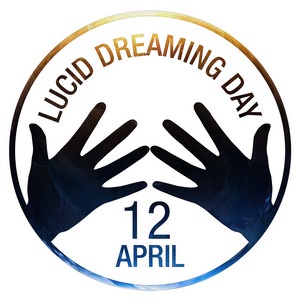PRESS RELEASE: First Ever Annual Lucid Dreaming Day – April 12
April 2014 - On April 12, 1975, graduate student researcher, Keith Hearne, saw the first credible evidence for lucid dreaming while glancing at the rapid eye movement (REM) polygraph readout of Alan Worsley in the University of Hull sleep lab.
Incredibly at 8:07 a.m., the sleeping Worsley realized within a dream that he was dreaming, and consciously recalled the experimental task: to move his eyes left to right eight times as a signal of his conscious awareness while dreaming. As Worsley looked left to right in the lucid dream, his physical eyes moved in tandem and the historic results were clearly visible on the REM polygraph readout. The first scientific evidence for lucid dreaming had been captured through the technique, now known as 'eye signal verification.'
In recognition of this profound moment in scientific history and to raise public awareness of lucid dreaming's scientific foundation, April 12th is being established as the annual Lucid Dreaming Day, according to organizers, Rebecca Casale of the popular World-of-Lucid-Dreaming.com website, lucid dreaming author Daniel Love, and Robert Waggoner and Lucy Gillis, coeditors of the magazine, Lucid Dreaming Experience. The organizers have received support for recognizing this historic day from researchers, authors and experienced lucid dreamers around the globe.
After seeing the first scientific evidence for lucid dreaming on April 12, 1975, researcher Keith Hearne remarked, "It was like getting signals from another world. Philosophically, scientifically, it was simply mind blowing." Since that time, interest in lucid dreaming has exploded. Recent surveys in scientific journals of college students show that almost 70% report having at least one lucid dream. Moreover, about 25% report that they become lucidly aware at least once a month.
Scientific research continues into lucid dreaming. Various experiments using EEG recordings and fMRI technology have shown at the moment of lucid awareness, parts of the brain associated with self awareness become active. When lucid, the dreaming brain and parts of the waking aware brain share concurrent activity. Additional research has considered using lucid dreaming to overcome recurring nightmares, often associated with Post Traumatic Stress Disorder, or PTSD.
Experienced lucid dreamers also report that lucid dreaming allows a person to directly access unconscious creativity. Aware in the dream, they can seek creative solutions to problems, which often lead to usable results in the waking world. Some lucid dreamers report the ability to positively influence emotional and physical health, while aware within the unconscious of dreaming, and look forward to the day when researchers investigate this potential use for lucid dreaming.
Organizers of Lucid Dreaming Day hope that by annually celebrating April 12th the public and scientific community will become aware of lucid dreaming's scientific basis and see the value in supporting research into lucid dreaming's potential as a tool to explore the unconscious mind and consciousness.
About Lucid Dreaming
Lucid dreaming is the ability to become conscious (self-aware) within the dream state. It is a scientifically proven sleep state that in recent years has been popularized, and somewhat fictionalized, by the blockbuster movie, Inception. Today there are millions of lucid dreamers in the world and millions more who seek to "wake up" in their dreams...
The result? An amazing virtual reality world, where everything looks and feels as vivid as waking life. And yet, like bending the rules of The Matrix, the laws of physics do not apply: anything is possible.
Further Information
Twitter/Facebook tag: #LucidDreamingDay
Visit the Lucid Dreaming Day Facebook page
Visit the Lucid Dreaming Day Facebook event











